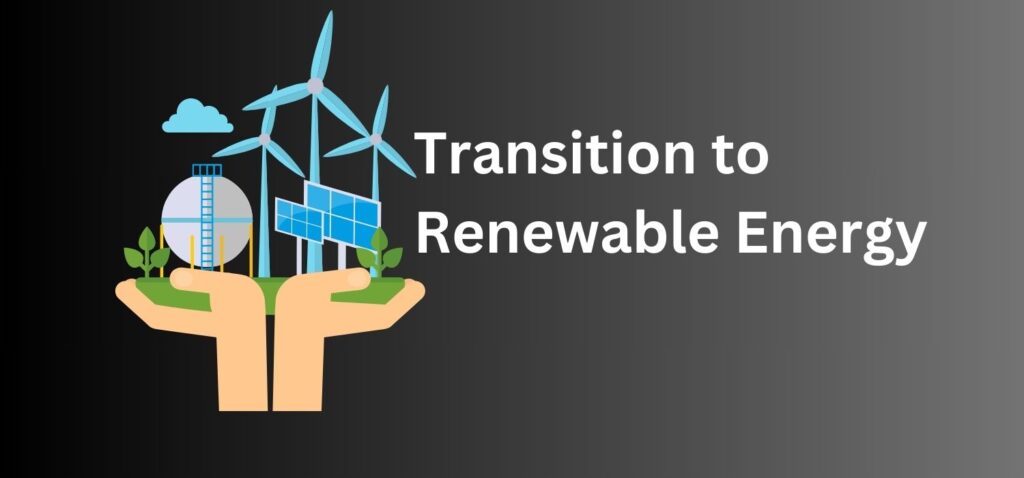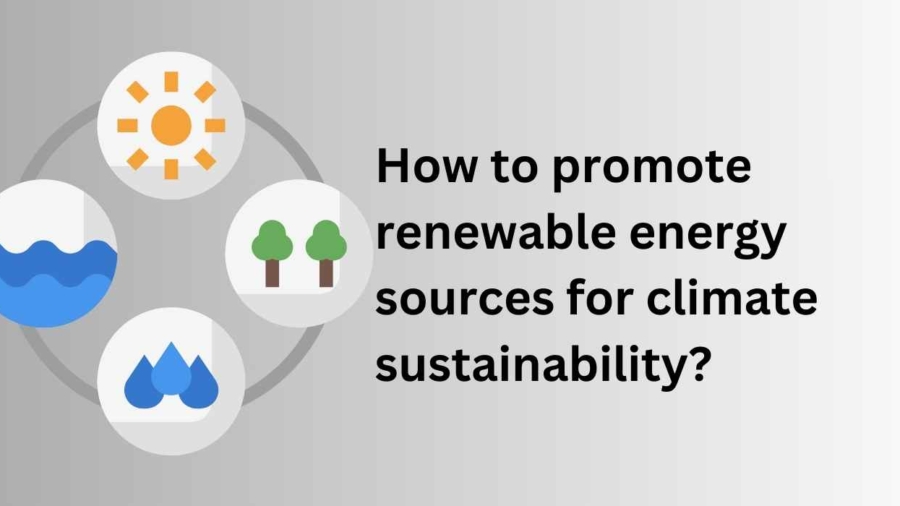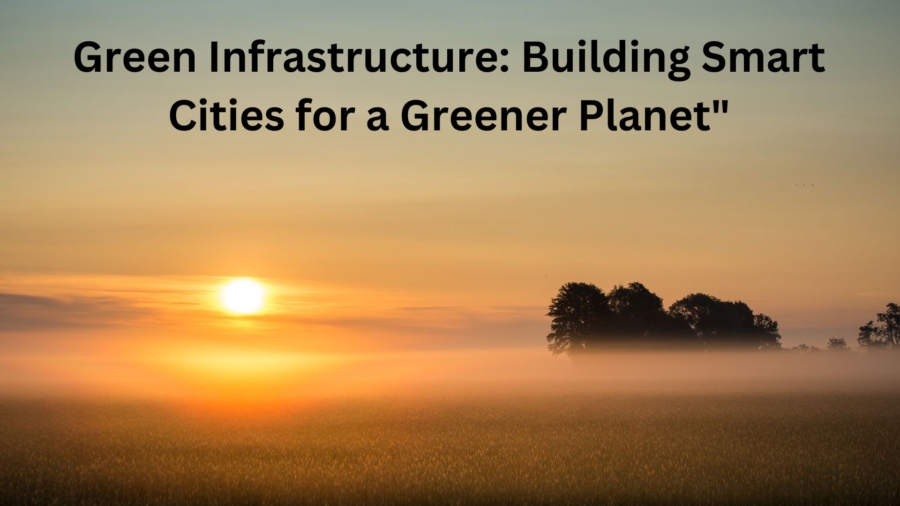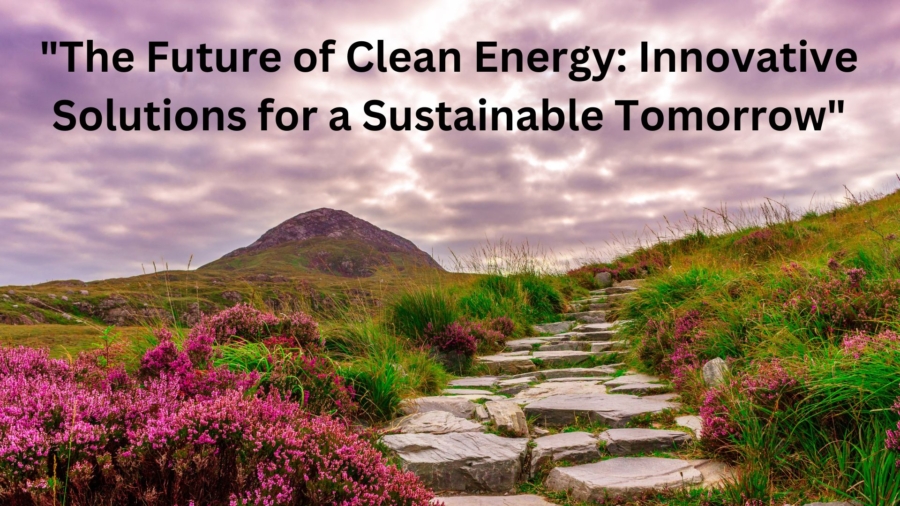The growing urgency of climate change has made it one of the most critical challenges of our time. From devastating natural disasters like floods, droughts, and wildfires to the slow but profound effects on ecosystems and human health, the need for effective solutions has never been more apparent. Among the most significant contributors to climate change are greenhouse gas emissions, primarily from the burning of fossil fuels for energy production. These emissions not only degrade the environment but also accelerate global warming, leading to catastrophic long-term impacts.
Renewable energy sources have emerged as a key solution in combating climate change and ensuring a sustainable future for generations to come. Unlike fossil fuels, renewable energy sources such as solar, wind, hydroelectric, and geothermal power generate electricity with little to no harmful emissions. They offer a cleaner alternative to the traditional methods of power generation that have dominated the global energy sector for over a century.
The transition to renewable energy is crucial because it can significantly reduce the amount of carbon dioxide and other pollutants released into the atmosphere. The burning of coal, oil, and natural gas is responsible for the majority of global emissions, but by shifting to renewable energy, we can drastically lower our carbon footprint. This change is not only necessary for mitigating the effects of climate change but also for protecting biodiversity, human health, and ensuring energy security.
In addition to environmental benefits, renewable energy offers significant economic opportunities. Investing in renewable energy infrastructure can create jobs, reduce dependence on imported fuels, and stimulate local economies. The expansion of renewable energy technologies provides new avenues for innovation, creating green jobs in manufacturing, engineering, installation, and research and development. With an increasing demand for cleaner energy, the renewable energy sector has become a thriving global industry with tremendous growth potential.
Moreover, renewable energy systems provide energy security by diversifying the energy supply. Unlike fossil fuels, which are finite and often subject to geopolitical tensions, renewable energy is abundant and locally available. Whether it’s the sun shining, the wind blowing, or water flowing, these resources are renewable and can be harnessed indefinitely, reducing the risks of energy shortages and price volatility associated with fossil fuels.
The adoption of renewable energy sources is also critical in achieving the global goals set out in the Paris Agreement, where nearly every country in the world has committed to reducing emissions and limiting global warming to below 1.5°C above pre-industrial levels. Renewable energy is central to meeting these ambitious targets. Countries that invest heavily in renewable technologies are positioning themselves as leaders in the transition to a low-carbon economy, enhancing their competitiveness in the global market while contributing to global climate goals.
However, while renewable energy presents an enormous opportunity, its widespread adoption faces several challenges. There are still financial, technological, and political barriers that slow down the transition. These include the high upfront costs of renewable energy infrastructure, the intermittent nature of some renewable sources like solar and wind, and the need for large-scale energy storage solutions. Furthermore, governments and industries need to develop and implement policies that create a favorable environment for renewable energy investments, ensuring a smooth transition away from fossil fuels.
Despite these challenges, the potential benefits of renewable energy far outweigh the obstacles. As we move forward, it is essential that we harness the power of renewable sources to drive forward the global shift towards a sustainable, low-carbon future. This requires collaborative efforts from governments, businesses, communities, and individuals to promote, invest in, and adopt renewable energy solutions that will help protect the planet for future generations.
In this section, we will explore the different types of renewable energy sources, their benefits, and the steps needed to accelerate their adoption for a more sustainable and resilient world.
Benefits of Renewable Energy

Renewable energy offers several significant advantages that contribute to a more sustainable and resilient future. These benefits span environmental, economic, and social aspects, making renewables a critical component in the fight against climate change.
1. Reduction in Greenhouse Gas Emissions
Renewable energy sources, such as solar, wind, and hydro, produce little to no greenhouse gas emissions, which are the primary contributors to global warming. By transitioning to renewables, we can significantly reduce carbon emissions, helping to mitigate climate change and its associated impacts, such as extreme weather events.
2. Economic Advantages
Renewable energy drives economic growth by creating jobs in manufacturing, installation, and maintenance. It also promotes energy independence by reducing reliance on imported fossil fuels, saving money and stabilizing energy prices. Additionally, renewable energy systems have low operational costs, offering long-term savings for consumers and businesses.
3. Energy Access and Poverty Reduction
Renewable energy can provide affordable, reliable energy to off-grid and underserved communities, particularly in rural areas. This can improve access to healthcare, education, and clean water, while also empowering local businesses and reducing energy poverty.
4. Energy Security and Reliability
Renewable energy enhances energy security by diversifying the energy supply. Unlike fossil fuels, which are vulnerable to geopolitical instability and supply disruptions, renewable sources like wind and solar are locally available and can be integrated into decentralized systems, improving resilience during natural disasters and other emergencies.
5. Biodiversity Preservation
Renewable energy has a smaller environmental footprint compared to fossil fuel extraction, helping to preserve ecosystems and reduce habitat destruction. By relying on renewable resources like sunlight and wind, we can conserve natural habitats and reduce pollution, supporting biodiversity.
Types of Renewable Energy

Renewable energy comes from natural resources that are replenished on a human timescale, making them an essential solution for achieving climate sustainability. There are several types of renewable energy sources, each with unique characteristics and potential applications. These include solar, wind, hydroelectric, geothermal, and biomass energy. Let’s explore each of them in detail:
1. Solar Energy
Solar energy is harnessed from the sun’s rays using photovoltaic (PV) panels or concentrated solar power (CSP) systems. Solar energy is abundant and can be used in virtually any location, whether on a large scale for solar farms or on a smaller scale for residential rooftop installations. The flexibility, low environmental impact, and decreasing costs of solar technology make it one of the most popular and promising renewable energy sources worldwide.
2. Wind Energy
Wind energy is generated by converting the kinetic energy of wind into electricity using wind turbines. Wind power is one of the fastest-growing renewable energy sources globally, particularly in regions with consistent and strong winds. Offshore and onshore wind farms are being developed to take advantage of wind resources, providing clean electricity with minimal environmental impact. Wind energy offers a significant potential for large-scale power generation and is key to transitioning to a low-carbon economy.
3. Hydroelectric Energy
Hydropower is one of the oldest and most widely used forms of renewable energy. It involves generating electricity by harnessing the energy of flowing water, typically through dams on rivers. Hydroelectric plants can vary in size, from large-scale dams to small run-of-river projects. While large-scale hydropower has proven effective in providing significant amounts of energy, smaller projects can offer a more sustainable and less disruptive alternative. Hydropower is highly reliable and can produce continuous energy, making it a valuable resource for grid stability.
4. Geothermal Energy
Geothermal energy comes from the heat stored beneath the Earth’s surface. This heat can be harnessed for electricity generation or direct heating applications. Geothermal power plants are typically located near geothermal hot spots, such as areas with volcanic activity. This form of energy is highly efficient and provides a stable, continuous supply of power, regardless of weather conditions. While geothermal resources are geographically limited, they offer a reliable and low-carbon alternative to fossil fuels.
5. Biomass Energy
Biomass energy is produced from organic materials such as wood, agricultural waste, and food waste. These materials are burned or converted into biofuels to generate electricity or heat. Biomass can also be processed into liquid fuels like ethanol or biodiesel, providing an alternative to gasoline and diesel for transportation. Biomass energy is considered carbon-neutral because the carbon dioxide released during combustion is offset by the carbon absorbed by the plants during their growth. However, its environmental impact can vary depending on the type of biomass and its sourcing.
Challenges in Promoting Renewable Energy
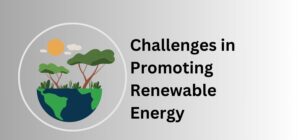
While renewable energy presents a clear path toward a sustainable future, its widespread adoption faces several challenges that must be addressed to accelerate its global integration. These challenges range from financial and technological barriers to policy and infrastructure limitations. Overcoming these obstacles requires coordinated efforts from governments, businesses, and communities. Let’s explore the key challenges in promoting renewable energy:
1. High Initial Costs
One of the most significant barriers to the widespread adoption of renewable energy is the high upfront cost of installation and infrastructure. While renewable energy systems such as solar panels and wind turbines have low operating and maintenance costs, the initial investment can be prohibitively expensive for many individuals, businesses, and governments, particularly in developing countries. In addition, energy storage technologies, essential for managing the intermittent nature of some renewables, also require significant capital investment.
To overcome this challenge, it is crucial to implement financing mechanisms, such as subsidies, tax incentives, and low-interest loans, to lower the financial burden. Governments and international financial institutions can play a significant role in providing funding or supporting private investments in renewable energy projects.
2. Intermittency and Energy Storage
Many renewable energy sources, such as solar and wind, are intermittent—they depend on weather conditions and time of day. Solar energy is only available when the sun is shining, and wind power is reliant on wind speeds. This intermittency can create challenges for grid stability, particularly when renewable energy supplies a large portion of a country’s electricity needs.
Energy storage technologies, such as batteries and pumped hydro storage, can help address this challenge by storing excess energy generated during periods of high production and releasing it when production is low. However, energy storage solutions remain expensive and are still being developed for large-scale use. To fully integrate renewable energy into the grid, continued investment in energy storage and grid management technologies is essential.
3. Infrastructure Limitations
In many regions, existing energy infrastructure is outdated and designed to handle fossil fuel-based power generation. Integrating renewable energy into these grids often requires significant upgrades, including the installation of smart grids, modernized transmission lines, and improved distribution systems.
Additionally, renewable energy installations often need to be built in remote locations, far from population centers, which can lead to additional transmission and distribution challenges. In some cases, the infrastructure required to transport renewable energy may not be in place or may require significant investments, which can delay the widespread adoption of renewable energy.
4. Policy and Regulatory Barriers
Government policies and regulations play a pivotal role in promoting renewable energy adoption. However, in many countries, existing energy policies are still heavily favoring fossil fuels through subsidies and tax incentives. In some cases, renewable energy projects face bureaucratic red tape, permitting delays, and lack of support from local or national governments.
To overcome these barriers, governments need to implement favorable policies, including incentives for renewable energy investments, long-term renewable energy targets, and streamlined permitting processes. Public-private partnerships can also help accelerate the transition by leveraging both public policy and private innovation.
5. Public Awareness and Acceptance
Despite growing awareness about climate change, many communities remain unaware of the benefits and feasibility of renewable energy. Public resistance to large-scale renewable energy projects, such as wind farms or solar power plants, can sometimes be a significant barrier, often due to concerns about land use, visual impact, or potential environmental effects.
Building public support for renewable energy requires comprehensive education and outreach efforts. Demonstrating the long-term benefits, such as job creation, lower energy costs, and environmental protection, can help foster broader acceptance. Community engagement in the planning and development of renewable energy projects is essential for gaining local support
Strategies to Promote Renewable Energy
To accelerate the transition to renewable energy and overcome the challenges that hinder its widespread adoption, several key strategies can be implemented by governments, businesses, and individuals. These strategies focus on improving policy frameworks, encouraging innovation, and engaging communities to drive the adoption of clean energy solutions. Let’s explore some of the most effective strategies for promoting renewable energy.
1. Government Incentives and Policy Support
Government policies play a crucial role in promoting renewable energy. Incentives such as tax credits, subsidies, feed-in tariffs, and grants can make renewable energy projects more financially viable, especially for small businesses and individuals. These incentives lower the initial costs of renewable energy installations, making them more affordable and attractive to consumers.
Additionally, governments should set long-term renewable energy targets and commitments to demonstrate their commitment to transitioning away from fossil fuels. Clear and stable policies, such as renewable portfolio standards (RPS) or energy transition laws, can provide the regulatory certainty needed for investors to fund renewable energy projects.
2. Investment in Research and Development
Continued research and development (R&D) are essential for advancing renewable energy technologies, improving efficiency, and reducing costs. Investments in R&D can lead to innovations in energy storage, grid management, and smart technologies that can better integrate renewable energy into the existing infrastructure.
Public and private sector collaboration in R&D initiatives can drive the development of next-generation renewable technologies, such as more efficient solar cells, advanced wind turbine designs, and better battery storage systems. These innovations will make renewable energy even more accessible and reliable, facilitating its adoption on a larger scale.
3. Public Awareness and Education
Increasing public awareness about the benefits and feasibility of renewable energy is crucial for fostering support and encouraging action. Governments, non-governmental organizations (NGOs), and businesses can engage in educational campaigns to inform the public about how renewable energy works, its environmental benefits, and its potential to reduce energy costs.
Additionally, schools and universities can play a significant role by incorporating renewable energy topics into their curricula and offering specialized programs in sustainable energy fields. Public awareness campaigns can also address common misconceptions and concerns about renewable energy projects, such as the potential for disruption to local communities or ecosystems.
4. Decentralized Energy Systems and Community Projects
Promoting decentralized energy systems—where renewable energy is generated and consumed locally—can help accelerate adoption in communities that are off the grid or have limited access to centralized energy infrastructure. Solar panels, wind turbines, and microgrids can be deployed in rural or remote areas, reducing the need for expensive transmission lines and enhancing energy access for underserved populations.
Community-based renewable energy projects, where local residents are involved in the planning and development, can create a sense of ownership and pride while also boosting local economies. These projects can also help address social concerns by ensuring that the benefits of renewable energy remain within the community.
5. Private Sector Partnerships and Corporate Commitment
The private sector plays a critical role in driving the renewable energy transition. Companies can take action by adopting renewable energy for their own operations, setting corporate sustainability targets, and investing in clean energy technologies. In addition to reducing their carbon footprint, businesses that invest in renewable energy can also reduce operational costs in the long term, enhance their reputation, and attract environmentally conscious consumers.
Public-private partnerships (PPPs) are also effective in advancing renewable energy projects. These partnerships can pool resources and expertise, facilitating the large-scale deployment of renewable technologies. Through PPPs, businesses can collaborate with governments and NGOs to address infrastructure gaps, develop financing mechanisms, and create long-term strategies for integrating renewables into the energy mix.
6. Transitioning the Workforce
As the renewable energy sector grows, there will be a need for a skilled workforce to support the installation, maintenance, and innovation of renewable energy technologies. Workforce development programs, including retraining and upskilling initiatives for workers transitioning from fossil fuel industries, will be essential to ensure that the labor force is prepared for the growing renewable energy job market.
Governments and educational institutions can collaborate with businesses to design training programs that equip workers with the necessary skills to succeed in the renewable energy sector. This workforce transition is not only important for addressing potential job losses in traditional energy sectors but also for ensuring that the renewable energy industry has the expertise it needs to thrive.
Global Efforts to Promote Renewable Energy
The global transition to renewable energy is a critical element in addressing climate change and ensuring a sustainable future. Many countries, international organizations, and multinational corporations are taking significant steps to promote renewable energy, recognizing its role in reducing greenhouse gas emissions, enhancing energy security, and driving economic growth. These efforts are essential to achieving global climate goals, such as those outlined in the Paris Agreement.
1. International Agreements and Frameworks
International efforts to promote renewable energy are largely driven by agreements such as the Paris Agreement, which aims to limit global warming to well below 2°C, with efforts to keep it below 1.5°C. Under this framework, countries commit to reducing their carbon emissions, transitioning to renewable energy, and increasing energy efficiency.
Organizations such as the International Renewable Energy Agency (IRENA) play a key role in supporting governments and businesses worldwide in their renewable energy transition. IRENA provides policy advice, technical assistance, and promotes international cooperation to scale up the deployment of renewable energy technologies.
In addition, the United Nations’ Sustainable Development Goals (SDGs) include a target to ensure universal access to affordable, reliable, and modern energy, with a strong emphasis on the promotion of renewable energy as part of sustainable development.
2. Renewable Energy Investment and Financing
Global financial institutions, including the World Bank, International Monetary Fund (IMF), and regional development banks, are increasingly prioritizing renewable energy investments. These institutions provide funding for renewable energy projects in developing countries, where access to clean energy is often limited. They also help mobilize private sector investments through green bonds, climate finance initiatives, and other innovative financing mechanisms.
International climate funds, such as the Green Climate Fund, also support renewable energy projects in developing nations, assisting them in adapting to climate change and reducing their dependence on fossil fuels. By supporting large-scale renewable projects, these financial mechanisms help drive the global shift toward clean energy.
3. National Commitments and Renewable Energy Targets
Many countries around the world are adopting national renewable energy targets, pledging to significantly increase their renewable energy capacity over the next few decades. For instance, countries like Germany, Spain, and Denmark have made remarkable strides in integrating renewable energy into their national grids. These nations have set ambitious renewable energy targets, with Germany aiming to achieve 80% of its electricity from renewable sources by 2050.
China, the world’s largest emitter of greenhouse gases, has also made significant investments in renewable energy. It leads the world in solar and wind power capacity and continues to scale up its renewable energy initiatives through national policies and subsidies.
The United States, despite political fluctuations, has seen several states like California and New York adopting bold renewable energy mandates, which are pushing the country toward a cleaner energy future. These national commitments and targets are key to ensuring that the global energy transition stays on track.
4. Corporate Sustainability Initiatives
Many multinational corporations are taking proactive steps to promote renewable energy as part of their sustainability strategies. Companies such as Google, Apple, and Tesla have committed to sourcing 100% of their energy from renewable sources. This move not only helps reduce their carbon footprint but also sets an example for other businesses to follow suit.
Corporations are also driving innovation in renewable energy technologies, partnering with governments and research institutions to develop and scale up clean energy solutions. Corporate sustainability efforts are making renewable energy a central element of business operations and inspiring others to make similar commitments to address climate change.
5. Technological Collaboration and Innovation
International collaboration on renewable energy technology research and development is another critical aspect of the global transition. Multinational partnerships between governments, universities, and private companies are advancing breakthroughs in renewable energy technologies such as advanced solar panels, offshore wind turbines, and next-generation batteries for energy storage.
Countries are also sharing best practices and lessons learned from renewable energy projects, helping to scale up technology deployment and reduce costs globally. Collaborative initiatives, such as the Clean Energy Ministerial and Mission Innovation, bring together governments and stakeholders to accelerate the development and deployment of clean energy technologies.
The Future of Renewable Energy
The future of renewable energy is promising, with rapid advancements in technology, growing global commitment, and increasing awareness of the urgent need to address climate change. As the world continues to shift away from fossil fuels, renewable energy will play an even larger role in meeting the world’s energy needs while reducing environmental impact. The future of renewable energy involves not only expanding existing technologies but also developing new solutions to overcome current challenges. Let’s explore what the future holds for renewable energy:
1. Technological Innovation and Efficiency Improvements
The future of renewable energy will be shaped by continued technological advancements. Innovations in solar panels, wind turbines, and energy storage systems will increase efficiency, reduce costs, and enhance the reliability of renewable energy sources. For example, solar panels are becoming more efficient at converting sunlight into electricity, while wind turbines are being designed to capture more energy at lower wind speeds.
Energy storage technologies, such as batteries and pumped hydro storage, will become more affordable and capable of storing larger amounts of energy for longer periods. These improvements will help address the intermittency issues associated with solar and wind power, ensuring a more stable and reliable energy supply.
2. Decentralized Energy Systems
As renewable energy technologies become more affordable and accessible, we can expect to see a rise in decentralized energy systems. These systems, where energy is generated close to where it is used, will allow individuals, communities, and businesses to produce their own energy from solar panels, wind turbines, and other renewable sources.
Microgrids, which are small-scale, localized energy systems, will play a key role in ensuring energy access in remote and underserved areas. These decentralized systems also offer greater resilience, allowing communities to continue using power during grid outages or natural disasters.
3. Global Expansion and Energy Access
In the future, renewable energy will help address energy poverty by providing affordable and reliable electricity to remote and developing regions. Solar power, in particular, has immense potential for improving energy access in regions where traditional energy infrastructure is lacking. Decentralized renewable energy systems will allow rural and isolated communities to bypass the need for large-scale, centralized power plants, making clean energy accessible to millions of people.
Moreover, with global investments in renewable energy growing, many countries in the developing world will leapfrog fossil fuels and transition directly to renewable energy, accelerating the fight against climate change and fostering sustainable development.
4. Integration with Smart Technologies
The integration of renewable energy with smart technologies will revolutionize energy grids, making them more efficient, flexible, and adaptable. Smart grids, which use digital communication technologies to monitor and manage electricity usage, will play a crucial role in integrating renewable energy into existing infrastructure.
These grids will help balance supply and demand by efficiently managing energy storage, consumption, and distribution. For example, smart meters can help consumers optimize their energy usage, while advanced software can predict energy demand and adjust renewable energy generation accordingly. This integration will increase the overall stability and reliability of renewable energy systems.
5. Policy and Global Cooperation
As the world moves towards a cleaner energy future, the role of policy and international cooperation will become increasingly important. Countries will need to set clear renewable energy targets and implement supportive policies that encourage investment in renewable energy projects. This includes providing financial incentives, streamlining permitting processes, and creating a favorable regulatory environment.
Global cooperation will also be essential for achieving global climate goals. Through initiatives like the Paris Agreement, nations must collaborate to share knowledge, technologies, and resources in order to accelerate the transition to renewable energy worldwide. With coordinated efforts, renewable energy can become a key driver of global economic growth while reducing emissions and mitigating the effects of climate change.
Frequently Asked Questions (FAQ) – Promoting Renewable Energy
1. What is renewable energy?
Renewable energy refers to energy that is generated from natural resources that are replenished naturally, such as sunlight, wind, rain, tides, geothermal heat, and more. Unlike fossil fuels, which are finite and contribute to environmental degradation, renewable energy is sustainable and helps reduce carbon emissions, making it a key solution for combating climate change.
2. Why is renewable energy important for sustainability?
Renewable energy is crucial for sustainability because it helps reduce our dependence on fossil fuels, which contribute to climate change through greenhouse gas emissions. It also offers a cleaner and more sustainable alternative to traditional energy sources, improving air quality and protecting ecosystems. By shifting to renewables, we can ensure that future generations have access to clean and reliable energy.
3. What are the main types of renewable energy?
The main types of renewable energy include:
- Solar Energy: Harnesses the power of the sun to generate electricity through solar panels.
- Wind Energy: Captures the energy from wind using turbines to produce electricity.
- Hydropower: Uses the flow of water to generate power, typically through dams or river systems.
- Geothermal Energy: Uses heat from within the Earth to produce electricity or provide heating.
- Biomass: Converts organic materials, such as plant and animal waste, into energy.
4. What are the challenges of promoting renewable energy?
While renewable energy has great potential, several challenges need to be addressed:
- High Initial Costs: The upfront investment for renewable energy systems, including solar panels or wind turbines, can be expensive.
- Intermittency: Some renewable sources, like solar and wind, are intermittent, meaning they don’t produce energy all the time.
- Lack of Infrastructure: Existing energy grids may not be designed to handle the decentralized nature of renewable energy.
- Policy and Regulatory Barriers: Outdated policies and a lack of support for renewable energy projects can hinder progress.
5. How can governments help promote renewable energy?
Governments can promote renewable energy through:
- Incentives and subsidies to reduce the cost of renewable energy systems.
- Clear and stable policies such as renewable energy targets, tax credits, and regulations that encourage clean energy investment.
- Investments in research and development to advance renewable energy technologies and make them more affordable and efficient.
- International cooperation to share knowledge, technologies, and financial resources for global energy transitions.
6. What is the role of individuals in promoting renewable energy?
Individuals can contribute to promoting renewable energy by:
- Adopting renewable energy solutions in their own homes, such as installing solar panels or using energy-efficient appliances.
- Advocating for clean energy policies by supporting governments and businesses that prioritize sustainability.
- Educating others about the benefits of renewable energy and how it can reduce environmental impact.
7. Can renewable energy completely replace fossil fuels?
While renewable energy can significantly reduce reliance on fossil fuels, it may not fully replace them in all sectors immediately. However, with continued innovation in storage technologies, grid management, and energy efficiency, renewable energy can become the dominant energy source. Many experts believe that a combination of renewable energy, energy storage, and efficiency improvements will be key to transitioning to a low-carbon energy future.
8. How is renewable energy helping reduce climate change?
Renewable energy helps reduce climate change by lowering greenhouse gas emissions, which are the primary driver of global warming. Unlike fossil fuels, which release carbon dioxide (CO2) when burned, renewable energy systems do not emit greenhouse gases during operation. Transitioning to renewable energy is crucial for meeting global climate goals and mitigating the impacts of climate change.
9. How do renewable energy technologies impact the economy?
Renewable energy technologies can have a positive impact on the economy by:
- Creating jobs in manufacturing, installation, maintenance, and research.
- Stimulating local economies by supporting small businesses and community-based energy projects.
- Reducing energy costs in the long term, as renewable energy systems often have lower operational costs compared to fossil fuel power plants.
10. What is the future of renewable energy?
The future of renewable energy is bright, with ongoing advancements in technology, such as more efficient solar panels, larger wind turbines, and better energy storage solutions. With increasing global support, renewable energy is expected to become more widespread and affordable. As more countries and industries make commitments to sustainability, renewable energy will play a central role in creating a cleaner, more sustainable energy future for the world.
Conclusion
The future of renewable energy is filled with opportunity and potential. Technological innovations, decentralized energy systems, expanded global access, integration with smart technologies, and supportive policies will all contribute to a cleaner, more sustainable energy future. By continuing to invest in renewable energy, collaborate across borders, and harness the power of innovation, we can create a world powered by clean, reliable, and affordable energy for generations to come.







